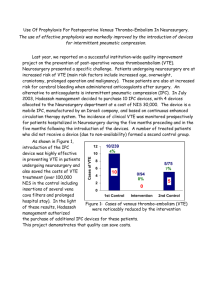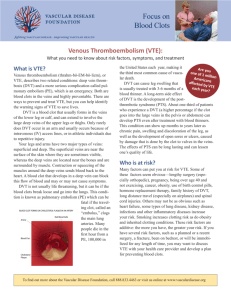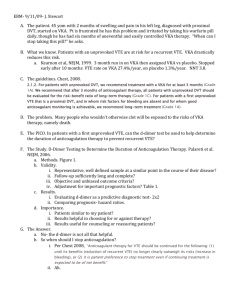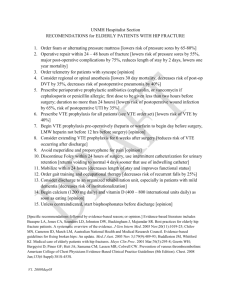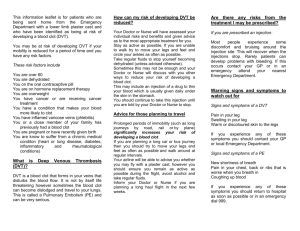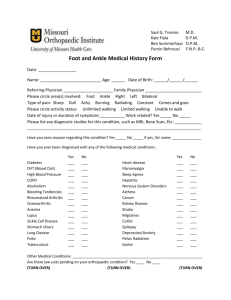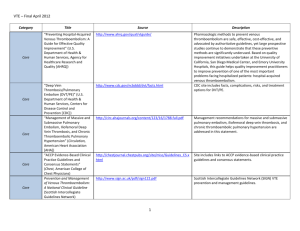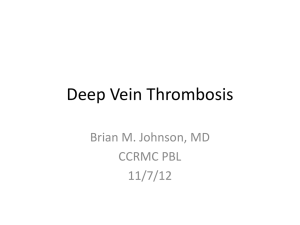Reducing Blood Clots In Adult Patients
advertisement
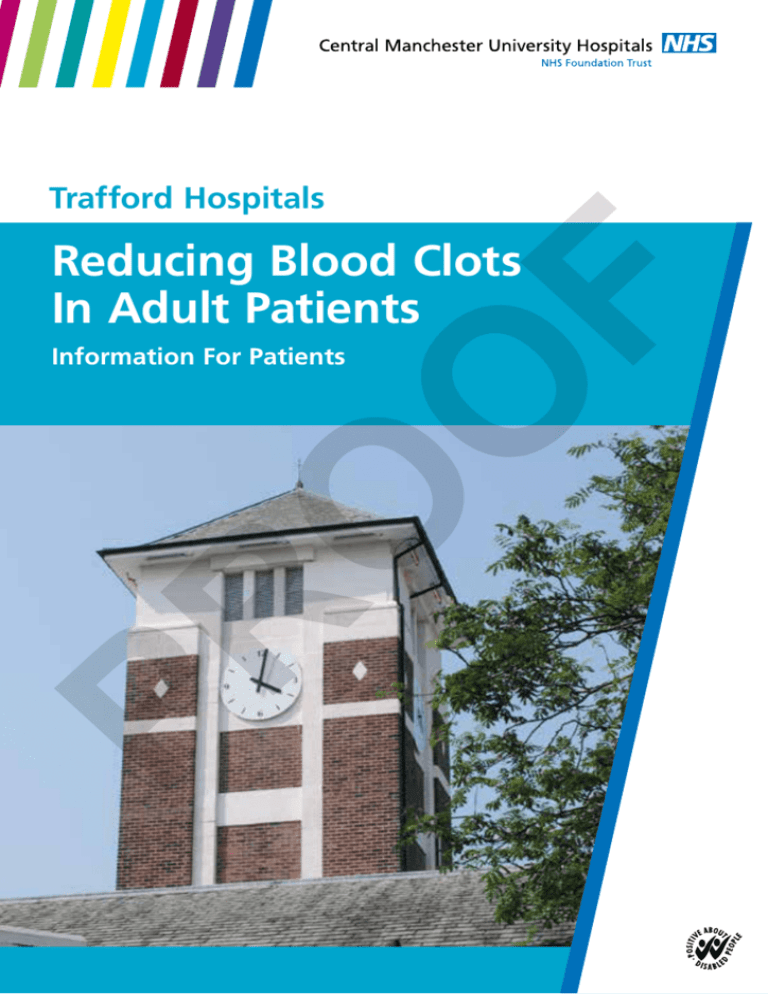
Trafford Hospitals F Reducing Blood Clots In Adult Patients PR O O Information For Patients 1 This leaflet will give you some idea about how to reduce the risk of developing blood clots during your stay in hospital. If you need further information, please ask a member of the medical or nursing team to explain how blood clots can be prevented during your stay in the hospital. What Is A Venous Thromboembolism? F Venous thrombosis is a condition in which a blood clot forms, often in the deep veins in the calf, thigh or pelvis. This is also known as deep vein thrombosis (DVT). Veins are blood vessels that return blood to the heart. When you have a DVT the blood flow in the vein is partially or completely blocked. O An embolism is created if a part or all of the blood clot in the deep vein breaks off from the site where it is created and travels through the venous system. This is called Venous Thromboembolism (VTE). The clot will usually lodge in the lung giving rise to a very serious condition called pulmonary embolism (PE). PR O Venous thromboembolism is a common cause of many hospital deaths. Each year over 25,000 people in England and Wales die from VTE. Vein within calf muscle Part of the clot may break off and travel up the vein Blood clot stuck to inside lining of the vein Vein wall 2 What Causes VTE? VTE can be an inherited problem (inherited thrombophilias) that allows the blood to clot easily. Some medical conditions will increase the risk of blood clot. These are discussed later on. What Are The Symptoms Of VTE? O F The typical symptoms are pain, tenderness, and swelling of the calf. Blood that would normally go through the blocked vein is diverted to outer veins. The calf may then become warm and red. Sometimes there are no symptoms and a DVT only becomes apparent when pulmonary embolism (PE) develops (see below). Symptoms of a PE include breathlessness, chest pain and, in severe cases, collapse. Both DVT and PE are serious conditions and require urgent investigation and treatment. How Serious Is VTE? O When a blood clot forms in a leg vein it usually remains stuck to the vein wall. The symptoms tend to settle gradually, but there are two main possible complications. PR • Pulmonary embolus – This is a break-away part of a blood clot that travels in the blood stream, up the larger veins in the legs and body, through the heart chambers to lodge in a blood vessel in the lungs. It occurs in a small number of people who have a DVT. Pulmonary embolus is serious, and can sometimes be fatal. • Post-thrombotic syndrome – Without treatment, up to 6 in 10 people who have a DVT develop long-term symptoms in the calf. Symptoms occur because the increased flow and pressure of the diverted blood in other veins can affect the tissues of the calf. Symptoms can range from mild to severe and include: calf pain, discomfort, swelling, and rashes. An ulcer on the skin of the calf may develop in severe cases. Post-thrombotic syndrome is more likely to occur if the DVT occurs in a thigh vein, or extends up into a thigh vein from a calf vein. It is also more common in people who are overweight, and in those who have had more than one DVT in the same leg. 3 Who Is At Risk Of Having A VTE? Anyone may develop a VTE, but the following increase the risk. • Immobility causes blood flowing in your veins to slow down. Slow flowing blood is more likely to clot than normal flowing blood. • A surgical operation which lasts more than 60 minutes. Under anaesthetic, your legs are still, and the blood flow in your veins slows down. • Any illness or injury that causes immobility increases the risk of a VTE. F • Long journeys by plane, train and car may increase the risk of VTE slightly. This is most likely due to sitting in a cramped position for long periods. O • Damage to the inside lining of the vein increases the risk of a blood clot forming. For example, a DVT may damage the lining of the vein. So, if you have a DVT, then you have a higher than average risk of having another one sometime in the future. O • Some conditions such as vasculitis (inflammation of the vein wall) and some drugs (for example, some chemotherapy drugs) can damage the vein and increase the risk of having a VTE. • Conditions that cause the blood to clot more easily than normal (thrombophilia) can increase the risk of having a VTE. PR • Some medical conditions can cause the blood to clot more easily than usual. For example, nephrotic syndrome (a kidney problem) and antiphospholipid syndrome. • Some rare inherited conditions can also cause the blood to clot more easily than normal. • The birth control pills (combined contraceptive pill) and hormone replacement therapy (HRT) which contain the female hormone, oestrogen can cause the blood to clot slightly more easily. Women taking ‘the pill’ or ‘HRT’ have an increased risk of VTE especially after major surgery. You may want to consider alternative methods of birth control, and if so contact your GP or local family planning clinic. It is important to note that there is no increased risk from the progestogen-only pill (‘minipill’). 4 • People with cancer or heart failure have an increased risk of having a VTE. • Older people (above 60 years) are more likely to have a VTE, particularly if they have poor mobility or have a serious illness such as cancer. • Pregnancy increases the risk. About 1 in 1000 pregnant women has a VTE. • Obesity also increases the risk of having a VTE. F How Can Venous Thromboembolism Be Prevented During and After Your Admission? O Things that may help to prevent a first or recurrent VTE include the following: O • Avoid long periods of immobility such as sitting in a chair for many hours. If you are able, get up and walk around. A daily brisk walk for 30-60 minutes is even better if you can do this. The aim is to stop the blood ‘pooling’, and to get the circulation in the legs moving. • Regular exercise of the calf and foot muscles. You can do some calf exercises even when you are sitting. • Drink plenty of water to avoid dehydration. PR • Major surgical operations are known to be a risk for a VTE – particularly operations to the hip, lower abdomen, and leg. –– You may be asked to wear elastic compression stockings by the ward staff. –– For those at moderate to high risk, you may be given a blood thinner (anticoagulant) such as a heparin-type injection. –– An inflatable sleeve connected to a pump to compress the legs during a long operation may also be used. –– It is also common practice to get you up and walking as soon as possible after an operation. 5 Elastic Compression Stockings There is some evidence to suggest that compression stockings can help to prevent DVT. The ward staff will give you advice about the correct stockings and size to wear. The slight pressure from the stocking helps to prevent blood ‘pooling’ in the calf. Stockings do not replace the need for regular exercises. They are in addition to exercises. Anticoagulant Medication F Some people at moderate to high risk of VTE will be advised to have a heparin-type injection while a hospital patient. Heparin is an anticoagulant (it ‘thins the blood’ and makes it less likely to clot). See your Doctor before any operation to discuss this option if you: O • Have had a previous DVT or pulmonary embolus. • Have a family history of clotting conditions. • Have cancer, or had treatment for cancer in the past. O • Had major surgery in the last three months. In particular if you had a hip or knee replacement within the last 3 months. • Have had a stroke. • Have had a recent long flight or journey greater than 3 hours. PR Your Surgeon will assess your risk for developing a VTE and give you treatment to prevent a VTE accordingly. In summary • The main cause of VTE is immobility. • The most serious complication of VTE is a pulmonary embolus where part of the blood clot breaks off and travels to the lung. • Persistent calf symptoms may occur after a DVT. • With treatment, the risk of complications is much reduced. • Prevention includes anticoagulation, compression stockings, leg elevation, and keeping active. • Prevention is important if you have an increased risk of VTE. 6 Further advice: www.patient.co.uk/showdoc/23068982 www.nhs.uk – Regarding travel related DVT – see their website www.dh.gov.uk/PolicyAndGuidance/ HealthAndSocialCareTopics/ BloodSafety/VTE/DVT/fs/en Zero Tolerance Policy F We are committed to the well-being and safety of our patients and of our staff. Please treat other patients and staff with the courtesy and respect that you expect to receive. Verbal abuse, harassment and physical violence are unacceptable and will lead to prosecutions. O Suggestions, Concerns and Complaints If you wish to make a comment, have a concern or want to complain, it is best in the first instance to speak to the manager of the ward or department involved. O The Trust has a Patient Advice and Liaison Service (PALS) who can be contacted on (0161) 276 8686 and via e-mail: pals@cmft.nhs.uk. They will help you if you have a concern, want advice, or wish to make a comment or complaint. PR Information leaflets about the service are readily available throughout the Trust. Please ask any member of staff for a copy. 7 F O O PR TIG 70/14 Produced October 2015 Review 8 Date October 2017 (SF Taylor CM15245)

